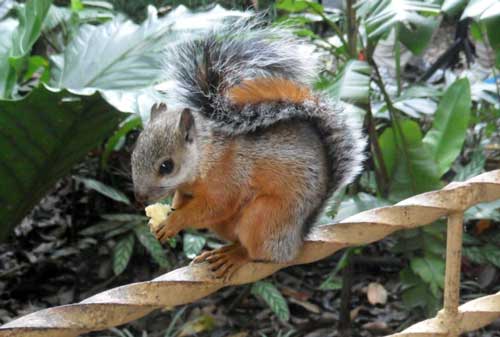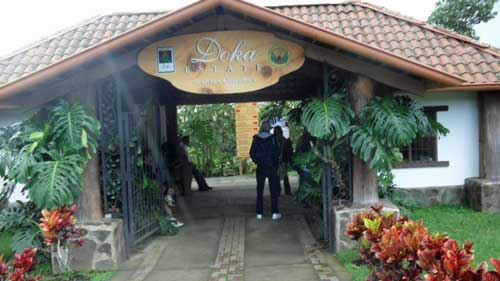
By Judy Pinegar
The day began with another full breakfast at Hotel Aranjuez in San Jose, and except for the made to order omelet and the typical rice and beans, every dish was a new item! Wonder how many days they can keep this up?? Today our table was visited by a local squirrel, exciting all us tourists, so of course we took a picture too.
We decided to visit a coffee plantation in the nearby hills of Jan Jose, over 3000 ft altitude. We picked the Doka Estate, out of Alajuela as they offered tours even if it rained. The drive was supposed to be 45 minutes to an hour, but after about an hour we found our taxi driver had never been there either. Luckily I had the phone number and our taxi driver had a cell phone, so we got there 5 minutes after our reservation, and the tour hadn’t left yet. True to the ad, it was a “seed to cup” tour. We learned it takes a full year to grow the seeds into a plant, ready to be transplanted to a bigger container, and another year to grow the plant to be ready to plant in the field.
The plant is more of a shrub than a tree, the top of each one can be reached by the arms of the picker (migrant workers from Nicaragua or Panama), who picks each berry individually, only when they are red, so a plant has to be picked many times, from October until February of each year. They fill a basket, tied around their waist, which when full weighs 25 pounds. A very good picker can pick 30 baskets a day, and gets paid $1.00 per basket!!
After that the berries are taken to a wash bath where they are re-measured, then dumped into a water bath. The good quality beans sink, and are exported, the bad ones float and are sold in Costa Rica!! They are then again processed so the outer red shell comes off leaving from 1 to 3 seeds and again are sorted by size into three categories (biggest is best). After that they are “fermented” for 3 days in a large open vat with some water. It is a natural fermentation, the guide didn’t know what caused it, but I assume it was natural (or wild) yeast, as she said nothing was added. The alcohol and some water is then siphoned off and shipped to another company that makes coffee liquor.
The remaining beans are then dried for 3 days on a concrete pad in the sun and are raked to turn over, every 30 minutes 24/7! After that they spend another day in a gas fired dryer, rotated constantly. They are then stored in bags for 3 months (the berry is still “green”). Then most of the beans are exported in that condition as the gourmet coffee companies (Starbucks gets 60 % of this plantation’s crop), like to do their own secret roasting and blending.
Then we saw a roasting room where three levels (light, medium and dark) or roasting is done. This is a very small plant as the only coffee they roast is that sold in their own tourist shop, and are the very highest quality of beans. The low quality beans are sent to another Costa Rican company to roast for the locals and all export beans are sold green.
Tastes of their 7 blends were then offered (John and Ted imbibed; I just toured the gift shop). An interesting fact was that to make decaffeinated coffee the beans are shipped to Germany, where they were decaffeinated through a water process at NO cost, because the German company sells the Caffeine all over the world for other purposes. Doka Estate only pays to ship them over and back to Costa Rica. But again this is a very small % of the crop. All in all it was a very interesting tour taking about 2 hours whicha I would recommend to any visitor.
You can buy their coffee by mail order here is their website Doca Coffee Plantation
Judy Pinegar is a writer and her articles have appeared in numerous publications
.
For all your real estate needs
Call or email
John J. O’Dell® GRI
Real Estate Broker
O’Dell Realty
(530) 263-1091
jodell@nevadacounty.com
